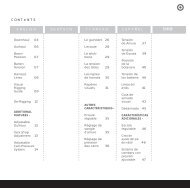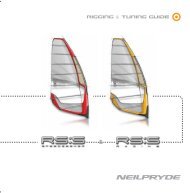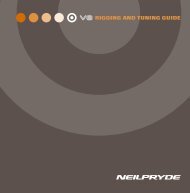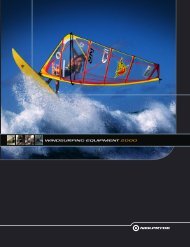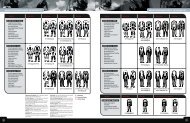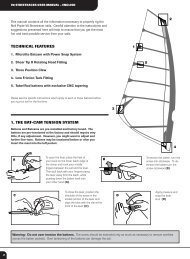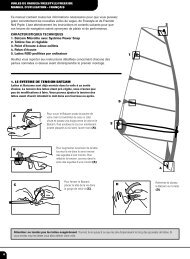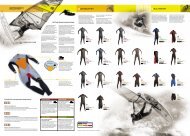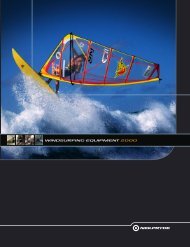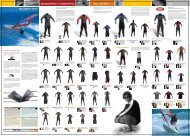shock 1997 user manual - Neil Pryde
shock 1997 user manual - Neil Pryde
shock 1997 user manual - Neil Pryde
Create successful ePaper yourself
Turn your PDF publications into a flip-book with our unique Google optimized e-Paper software.
Shock 6.1<br />
The 6.1 also features a relatively firm leech. Downhaul<br />
until the leech is slightly loose at the first batten and<br />
perhaps just a little soft between battens 1 and 2.<br />
Then outhaul 2 -4 cm beyond the “0” (no<br />
tension) point depending on wind<br />
conditions. When over-powered,<br />
increase outhaul tension by 1 - 2 cm.<br />
If the sail feels stiff and “pitchy”, it is<br />
probably over-downhauled. If the<br />
sail feels unstable or difficult to<br />
sheet in, it is probably underouthauled.<br />
Shock 7.0<br />
The 7.0 has the loosest leech of any of the four Shock sizes.<br />
Downhaul until the sail is loose to the second batten and a bit<br />
soft to batten # 3. As winds increase beyond the minimum<br />
required for planing, go ahead and downhaul until the sail is<br />
a bit looser between battens 2 and 3. Add outhaul<br />
between 2 and 4 cm past the “0” point --- more<br />
outhaul for improved control as wind speeds<br />
increase. When over-powered, increase outhaul<br />
tension by an extra 1 - 2 cm. If the sail feels stiff<br />
and “pitchy”, it is probably over-downhauled.<br />
If the sail feels unstable or difficult to sheet<br />
in, it is probably under-outhauled.<br />
A NOTE ON RIG DIMENSIONS<br />
The rig dimensions printed on the tack of all <strong>Neil</strong> <strong>Pryde</strong> collection sails<br />
show the following information:<br />
• Top setting (where relevant): The distance between the bottom of the<br />
mast head fitting (top of the mast) and the sail head (the intersection<br />
of luff pocket and upper leech).<br />
• Minimum luff length: The distance from the sail head to the bottom<br />
of the tack fitting at the lightest useful downhaul setting.<br />
• Maximum luff length: The distance from the sail head to the bottom<br />
of the sail tack fitting at the hardest downhaul setting.<br />
• Minimum boom: The distance from the forward edge of the mast (at<br />
the center of the boom cutout) to the sail clew at the fullest (lightest)<br />
useful outhaul setting.<br />
• Maximum boom: The distance from the forward edge of the mast (at<br />
the center of the boom cutout) to the sail clew at the flattest (hard<br />
est) useful outhaul setting.<br />
These figures are intended as a guide to proper sail trim, and,<br />
depending on the rig components you choose, may not always<br />
correspond perfectly to the settings which are best for you.<br />
1<br />
2<br />
1<br />
3<br />
CHOOSING THE RIGHT MAST<br />
Shock 6.1 correctly tuned at<br />
near maximum downhaul.<br />
2<br />
The Shock range of sails have been designed specifically around the<br />
Carbon 30/460 mast, and this spar is therefore recommended for best<br />
results. Other masts from the <strong>Neil</strong> <strong>Pryde</strong> collection can also be used, as<br />
can earlier <strong>Neil</strong> <strong>Pryde</strong> masts having the correct diameter to fit the luff<br />
pocket. Check with your <strong>Neil</strong> <strong>Pryde</strong> retailer if you are in doubt.<br />
3<br />
Shock 7.0 correctly tuned at<br />
near maximum downhaul.



